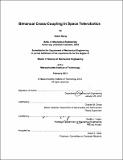Bimanual cross-coupling in space telerobotics
Author(s)
Wang, Victor, S.M. Massachusetts Institute of Technology
DownloadFull printable version (7.863Mb)
Other Contributors
Massachusetts Institute of Technology. Dept. of Mechanical Engineering.
Advisor
Charles M. Oman.
Terms of use
Metadata
Show full item recordAbstract
Astronauts spend much time training to control the robotic arm aboard the International Space Station, and must perform a variety of challenging, three-dimensional tasks. They use a unique, bimanual control system to control the velocity of the end-effector; the left hand controls translation in three axes while the right hand simultaneously controls rotation in three axes. Operator inputs to the bimanual controllers can cross-couple through not only inter-manual neuromotor pathways, when movement of one hand affects movement of the other hand, but also through intramanual pathways, when movement of one hand affects movement of the same hand in an unintended control axis. We developed a measurement technique to quantify these directional cross-coupling pathways based on the detection of frequency-coded command signals in a bimanual tracking task. The technique allowed us to characterize the interactions among all six control axes in the form of a cross-coupling matrix of coupling strengths. An experiment using these techniques suggested two principal pathways of intermanual coupling and one of intramanual coupling. By combining information across 18 human subjects to typify the cross-coupling response due to the bimanual control system, we found that the two intermanual pathways exhibited 21% yaw to lateral translation and 15% pitch to vertical translation mean coupling even after significant training. The intramanual pathway exhibited 41% roll to yaw mean coupling. We found significant differences in bimanual cross-coupling between subjects, and demonstrated that subjects could significantly reduce intermanual cross-coupling with practice, suggesting that these metrics may be useful indicators of control device mastery. We found statistically significant negative correlations between early-stage intramanual coupling and subsequent performance in a simulated space telerobotics track and capture task, suggesting that an intramanual coupling metric may be useful as a predictor of human telerobotic performance. The test technique could ultimately be applied to evaluate cross-coupling during astronaut training and also to reduce undesired cross-coupling through improved hand controller design. Our results supported an ergonomic basis for intermanual cross-coupling that incorporated both biomechanical effects and sensorimotor effects.
Description
Thesis (S.M.)--Massachusetts Institute of Technology, Dept. of Mechanical Engineering, 2012. Cataloged from PDF version of thesis. Includes bibliographical references (p. 54-61).
Date issued
2012Department
Massachusetts Institute of Technology. Department of Mechanical EngineeringPublisher
Massachusetts Institute of Technology
Keywords
Mechanical Engineering.